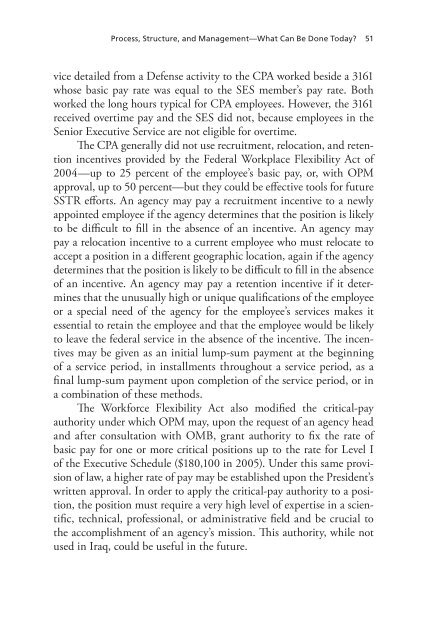Stabilization and Reconstruction Staffing - RAND Corporation
Stabilization and Reconstruction Staffing - RAND Corporation
Stabilization and Reconstruction Staffing - RAND Corporation
You also want an ePaper? Increase the reach of your titles
YUMPU automatically turns print PDFs into web optimized ePapers that Google loves.
Process, Structure, <strong>and</strong> Management—What Can Be Done Today? 51vice detailed from a Defense activity to the CPA worked beside a 3161whose basic pay rate was equal to the SES member’s pay rate. Bothworked the long hours typical for CPA employees. However, the 3161received overtime pay <strong>and</strong> the SES did not, because employees in theSenior Executive Service are not eligible for overtime.The CPA generally did not use recruitment, relocation, <strong>and</strong> retentionincentives provided by the Federal Workplace Flexibility Act of2004—up to 25 percent of the employee’s basic pay, or, with OPMapproval, up to 50 percent—but they could be effective tools for futureSSTR efforts. An agency may pay a recruitment incentive to a newlyappointed employee if the agency determines that the position is likelyto be difficult to fill in the absence of an incentive. An agency maypay a relocation incentive to a current employee who must relocate toaccept a position in a different geographic location, again if the agencydetermines that the position is likely to be difficult to fill in the absenceof an incentive. An agency may pay a retention incentive if it determinesthat the unusually high or unique qualifications of the employeeor a special need of the agency for the employee’s services makes itessential to retain the employee <strong>and</strong> that the employee would be likelyto leave the federal service in the absence of the incentive. The incentivesmay be given as an initial lump-sum payment at the beginningof a service period, in installments throughout a service period, as afinal lump-sum payment upon completion of the service period, or ina combination of these methods.The Workforce Flexibility Act also modified the critical-payauthority under which OPM may, upon the request of an agency head<strong>and</strong> after consultation with OMB, grant authority to fix the rate ofbasic pay for one or more critical positions up to the rate for Level Iof the Executive Schedule ($180,100 in 2005). Under this same provisionof law, a higher rate of pay may be established upon the President’swritten approval. In order to apply the critical-pay authority to a position,the position must require a very high level of expertise in a scientific,technical, professional, or administrative field <strong>and</strong> be crucial tothe accomplishment of an agency’s mission. This authority, while notused in Iraq, could be useful in the future.
















